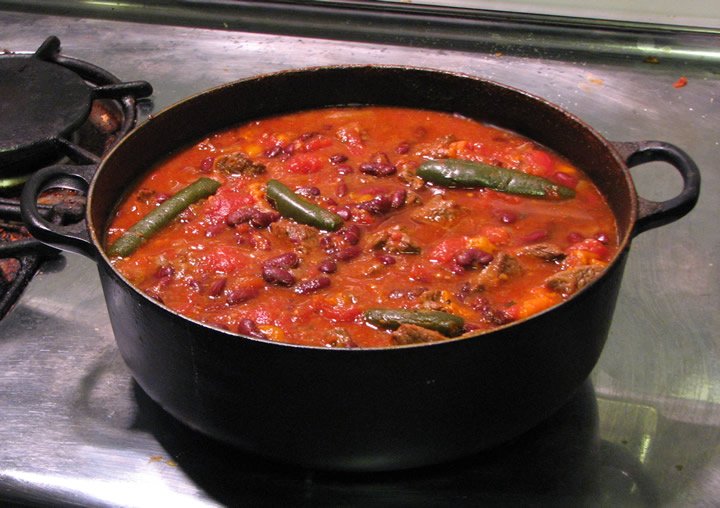It is a celebration in the field of #food, and it is a #vegetable product native to America, with a strong flavor. Today we have 'Chili Day'. Well, when I saw this in the listing of the day, I thought we were referring to the plant itself, and its fruit. But it's not about that, it's not about the plant that evolved in South America 9500 years ago, it turns out that it's about a day of celebration for a popular #dish in which Chili (or Chili peppers, or Chiles) is the one that It provides the spicy flavor that is the protagonist.
+++
Es una celebración en el campo de la #comida, y se trata de un producto #vegetal nativo de América, de fuerte sabor. Hoy tenemos el ‘Día del Chili’. Bien, cuando vi esto en el listado del día, pensé que nos referíamos a la planta en sí, y a su fruto. Pero no se trata de eso, no es sobre la planta que evolucionó en Sudamérica hace 9500 años, resulta que se trata de un día de celebración para un #platillo popular en el que el Chili (o Chili peppers, o Chiles) es el que aporta el sabor picante que es protagonista.
+++

Image's Source - Fuente de la Imagen
Although this plant, with its spicy fruit, seems to have originated in the territories of present-day Bolivia or Peru, its systematic cultivation was developed on a large scale in Mesoamerica, which is currently Mexico. Cultivation has been documented in Mexico for 6000 years. As the centuries passed, it became an integral part of the gastronomy of these towns. With the arrival of Europeans to the continent, around the beginning of the 16th century AD, one of the products they took to Europe were specimens of these plants and their seeds.
+++
Aunque esta planta, de fruto picante, parece que se originó en territorios de la actual Bolivia o Perú, su cultivo sistemático se desarrolló a gran escala, fue en Meso-América, lo que actualmente es México. Se ha documentado el cultivo en México desde hace 6000 años. Con el pasar de los siglos pasó a ser parte integral de la gastronomía de estos pueblos. Con la llegada de los europeos al continente, rondando los inicios del siglo XVI d.C, uno de los productos que se llevaron a Europa fueron ejemplares de estas plantas y sus semillas.
+++

Image's Source - Fuente de la Imagen
However, as I said, today's celebration is not for spicy seasoning, but for a particular dish. There happens to be a traditional stew recipe of meat, tomatoes, beans, onion and chili, which originated in what is now northern Mexico and had spread to many parts since the 19th century. By the middle of this century, North American settlers who had settled in that territory declared their independence and Texas was born, which after some time would become part of the United States.
To my surprise, today's celebration was not born from a Mexican initiative, but came from Texas, where it had been declared an Official State Dish, in 1977. I suppose it remained as a Mexican heritage in that territory and took root quite a bit well in popular taste.
Well, it's my turn to say goodbye, wishing you that you are well and that we can read again on another occasion
+++
Sin embargo, como he dicho, la celebración de hoy no es para el condimento picante, sino para un platillo particular. Sucede que hay una receta tradicional de guiso de carne, tomates, frijoles, cebolla y chili, que se originó en lo que actualmente es el norte de México y se había expandido por muchas partes desde el siglo XIX. Para mediados de este siglo, colonos norteamericanos que se han asentado en ese territorio, declaran su independencia y nace Texas, que luego de algún tiempo entraría a ser parte de los Estados Unidos.
Para mi sorpresa, la celebración de hoy, no nació de una iniciativa mexicana, sino que vino de Texas, en donde había sido declarado como Plato Oficial del Estado, en 1977. Supongo que quedó como una herencia mexicana en ese territorio y se arraigó bastante bien en el gusto popular.
Bien, ya me toca despedirme, deseándote que tú estés bien y que nos podamos leer de nuevo en otra oportunidad
+++

This challenge is an initiative of @flaxz
The 4 points to join the #IAmAliveChallenge, includes using the hashtag #alive to post to We Are Alive Tribe and earn ALIVE tokens.
Este desafío es iniciativa de @flaxz
Los 4 puntos para unirte al #IAmAliveChallenge, incluyen el uso de la etiqueta #alive para publicar en We Are Alive Tribe y ganar tokens ALIVE.













